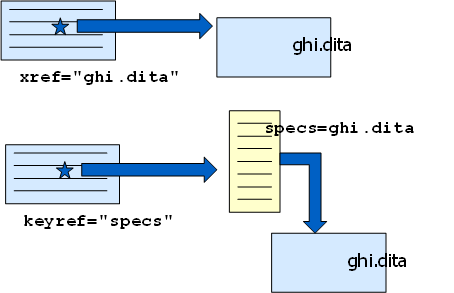Indirect linking with keys
Indirect linking and referencing is a way of specifying the target of a link or reference in the ditamap, rather than in the topic. The feature was introduced in DITA 1.2. This allows links to have different destinations, depending upon the ditamap in which the topic is used.
Indirection is an indirect method of linking, introduced in DITA 1.2. Instead of referring to the address of the resource, you refer to a key, which in turn refers to the address of the resource. As the key can be stored away from the topic in the ditamap, the same link or reference in a topic can point to different targets, depending upon the ditamap in which the topic is used.
Indirection opens up the opportunity to:
- redirect a link to a new target if an override is defined in the ditamap
- redirect a conref to a new target
- add text to a term or keyword
- turn terms into links
Key values are defined in a ditamap using the syntax keys="target
URI". To refer to a key in a topic, usually inside a
cross-reference (xref), term or image
element, a keyref attribute is used instead of the direct
href attribute. Indirection can also be used for content reference
transclusion by using the conkeyref attribute in place
of the direct conref attribute.
If the key referred to in a keyref attribute is not defined in the ditamap, the target reverts to the value of the href attribute, if defined.
<xref keyref="alpha" href="abc.dita">Alpha</xref>
Indirection has the effect of moving context from the topic to the map, which allows the topic to be re-used in more places.